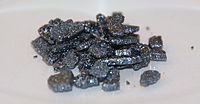
Interpreting the results of early skin tests after perioperative anaphylaxis requires special attention: a case report and review of literature
Sign Up to like & getrecommendations! Published in 2020 at "Journal of Anesthesia"
DOI: 10.1007/s00540-020-02802-x
Abstract: Skin tests are the gold standard for detecting the culprit drug of anaphylaxis, and should ideally be performed after an interval of 4–6 weeks after the reaction to avoid false-negative results. However, when re-operation cannot be… read more here.
Keywords: skin tests; results early; early skin; report ... See more keywords

Value of skin tests for managing allergic hypersensitivity reactions to platinum compounds
Sign Up to like & getrecommendations! Published in 2021 at "International Journal of Clinical Pharmacy"
DOI: 10.1007/s11096-021-01271-w
Abstract: Background Platinum-based therapy continues to be one of the pillars of the treatment of different types of cancer. However, many times the responsible clinician renounces its use after the appearance of a hypersensitivity reaction. Objective… read more here.
Keywords: skin tests; platinum; hypersensitivity reactions; platinum compounds ... See more keywords

Skin tests in the work‐up of cutaneous adverse drug reactions: A review and update
Sign Up to like & getrecommendations! Published in 2022 at "Contact Dermatitis"
DOI: 10.1111/cod.14063
Abstract: Skin tests, including patch tests (PTs), prick tests, and intradermal tests (IDTs), are useful in identifying the culprits of cutaneous adverse drug reactions (CADRs), and determining safer, alternative drugs. PTs have a low sensitivity but… read more here.
Keywords: drug reactions; adverse drug; cutaneous adverse; drug ... See more keywords

Non‐immediate‐reading skin tests and prolonged challenges in non‐immediate hypersensitivity to beta‐lactams in children
Sign Up to like & getrecommendations! Published in 2018 at "Pediatric Allergy and Immunology"
DOI: 10.1111/pai.12826
Abstract: A minority of children reporting non‐immediate reactions to beta‐lactams (BLs) are allergic. Allergy workup usually includes late‐reading (48‐72 hours) skin tests (ST) and short (1‐3 days) drug provocation tests (DPT), regardless of the chronology of… read more here.
Keywords: non immediate; skin tests; beta lactams; immediate hypersensitivity ... See more keywords

Intracutaneous Skin Tests and Serum IgE Levels Cannot Predict the Grade of Anaphylaxis in Patients with Insect Venom Allergies
Sign Up to like & getrecommendations! Published in 2022 at "Journal of Asthma and Allergy"
DOI: 10.2147/jaa.s367272
Abstract: Background Allergies against Hymenoptera venoms are a major cause of severe anaphylaxis. Risk assessment for subjects with suspected allergy is difficult because there are currently no biomarkers that predict the likelihood of high-grade anaphylaxis other… read more here.
Keywords: intracutaneous skin; grade anaphylaxis; anaphylaxis; venom specific ... See more keywords

The Role of Skin Tests in the Prevention and Diagnosis of Hypersensitivity Reactions to Platinum Agents in Gynecological Cancer: A Single-Center Italian Retrospective Study
Sign Up to like & getrecommendations! Published in 2021 at "Cancers"
DOI: 10.3390/cancers13215468
Abstract: Simple Summary The development of hypersensitivity reactions to platinum agents in patients with gynecological cancers limits the use of platinum re-treatment for recurrent disease. In those patients who developed a hypersensitivity reactions during treatment with… read more here.
Keywords: platinum; platinum agents; hypersensitivity reactions; skin tests ... See more keywords